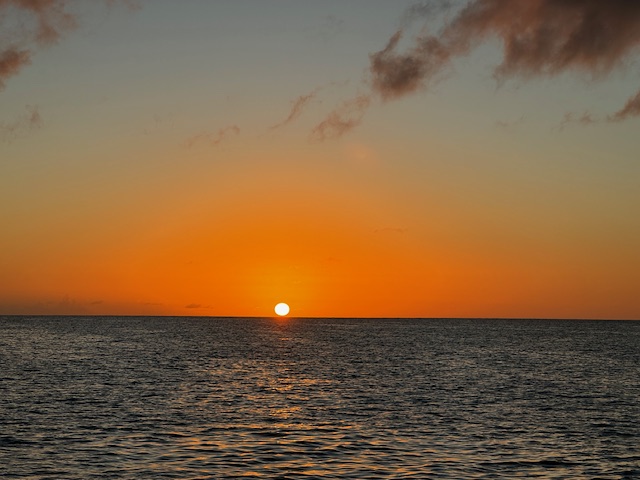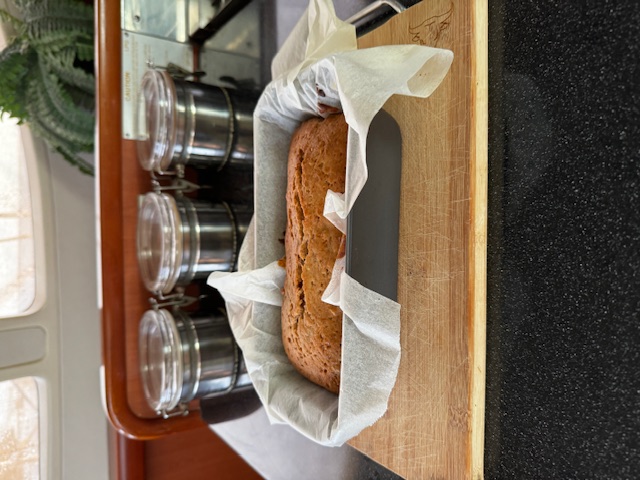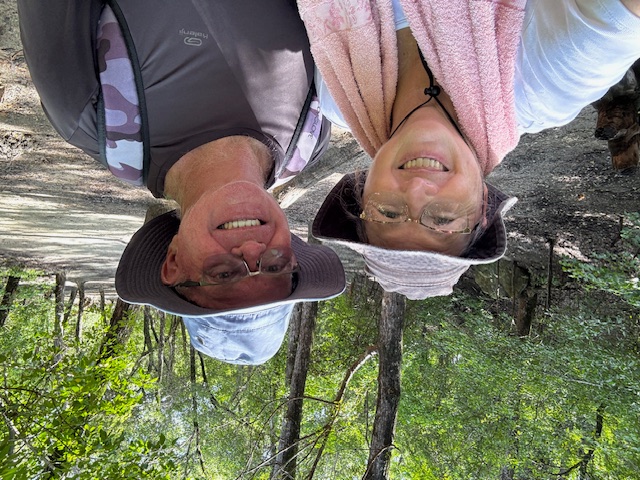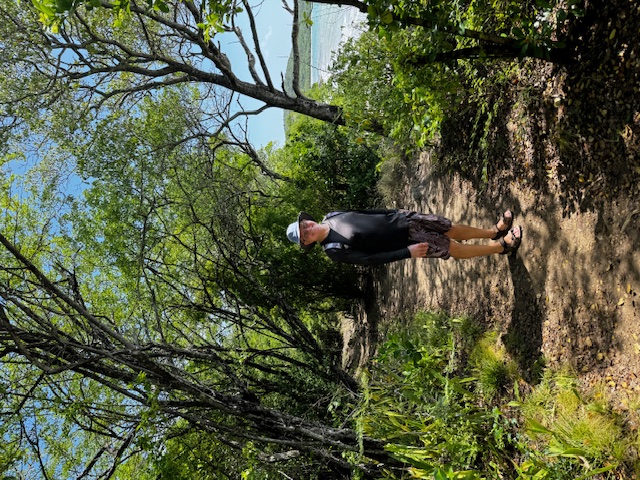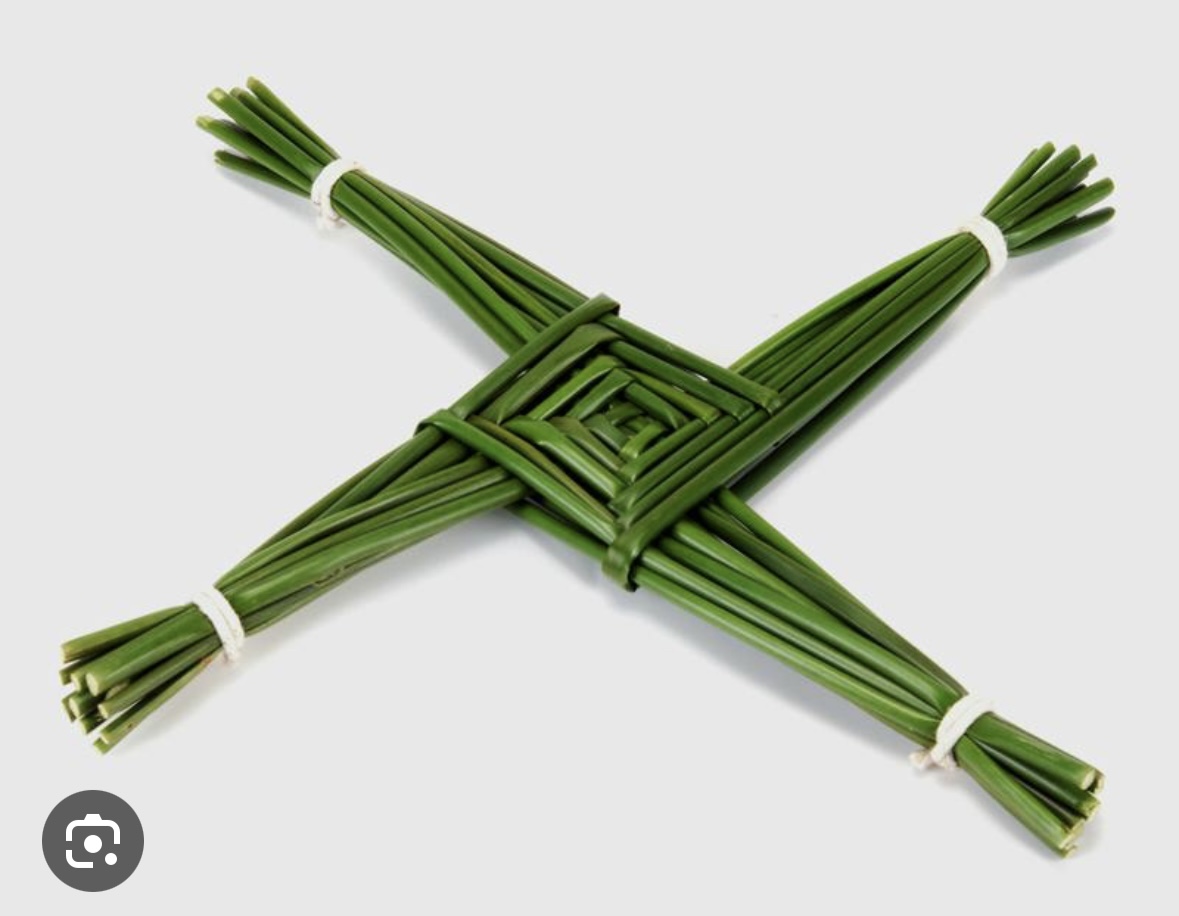Needless to say, pandemonium erupted with Roy rushing to secure the dinghy and Elaine grabbing the wheel to turn Paw Paw into the wind to slow her down. With a line installed to secure the dinghy, we limped back to Rodney Bay, anchored and replaced both shackles, to be sure, to be sure!
By the time we were underway again we’d lost two hours; so much for our early morning start, but we weren’t in any kind of a hurry anyway, other than to take advantage of the slightly better weather forecast for the morning. This, of course, didn’t materialise, leaving us to battle the elements all the way; 20-25 Kts of wind on the nose and 3 metre seas as the Atlantic Ocean tried to squeeze through the gaps between the islands into the Caribbean Sea, causing a leeway of 30 degrees, not to mention squall after squall. It was delightful for our first sail of the year! Not!
Regardless, by 1300 we were anchored off Sainte Anne’s; Elaine’s second “happy place” in the Caribbean behind Bonaire. Well, that was until we dinghied ashore to clear in after lunch. We did, however, have a large turtle come up to greet us as we arrived and could see a beautiful rainbow arched over the anchorage, this after having just as beautiful a rainbow the evening before in St Lucia. Nature was certainly showing us both sides of the same coin!
After more than 8 years since we were last in St Anne’s, change was expected, but we were very disappointed to see that the change was not a positive one; the pristine little seaside village, with its colourful flower boxes and inviting cafés, restaurants and boutique shops looked economically depressed, bordering on dilapidated.
A walk through the town revealed that the boulangerie, where Elaine had previously enjoyed the most delicious chaisson pomme, was still in existence, although closed at the time. Its café area on the beach, however, looked like it had been replaced by a separate restaurant. Nevertheless we made plans to get up early the next morning and return to the boulangerie to enjoy our breakfast of café au lait and chaisson pomme.
During our wanderings we also found the little fish market, but it too looked like it hadn’t been used in years. The most striking change, though, was the huge pier, where we used to tie up the dinghy, was completely absent and had been replaced by a smaller, less serviceable dock, with precious little facilities to secure the dinghy and a few stainless steel ladders to help one disembark. Saddened by what we found, we returned to Paw Paw. St Anne’s was simply no longer one of Elaine’s “ happy places”!
The following morning, full of anticipation, we were up early to dinghy back to St Anne’s to enjoy a breakfast at the boulangerie , only to discover that the bakery was under new management, the pastries didn’t look nearly as good as we remembered and coffee was no longer being served. With that, we decided to try our luck in Le Marin instead, but this too was just as disappointing, not to mention, our very uncomfortable dinghy ride, soaking us both in the process as standing waves in the channel splashed into the dinghy; it was definitely not the best day to have undertaken this trip.
This excursion, however, also left us empty handed when the boulangerie there was closed. Resigning ourselves to the fact that we probably weren’t getting café au lait and chaisson pomme for breakfast, something Elaine had been dreaming about for months prior to our arrival back in the Caribbean, we settled for a coffee and pain aux chocolat at a rather grubby “restaurant” in the marina called L’Annex.
This entire area was just as economically depressed with fences falling down, roads in a complete state of disrepair, buildings unpainted or boarded up and very few shops and restaurants open. Another massive change was the size of the marina and the number of yachts in the bay; it looked like something had “vomited up” yachts everywhere. The same was true for St Anne’s, which made it all the more baffling as to why these popular destinations could be in such a state of neglect.
Deciding that our focus needed to shift to enjoy our beautiful natural surroundings instead, rather than the disappointing manmade environments, on Sunday, 28th January 2024, we woke to our first sunny, rain free day in weeks and stayed onboard, enjoying a relaxing day, including breakfast in the cockpit and a swim off the back of Paw Paw. It’s fair to say the latter was very refreshing and a lovely break from the heat and humidity, exacerbated by all the rain that has plagued us for weeks. Seeing our friendly neighbourhood turtle popping up continuously throughout the day definitely helped us to refocus, acknowledging that we were definitely struggling with a completely different phase of our lives, one that didn’t involve a particular goal to achieve, other than playing the waiting game of getting Paw Paw sold and reestablishing ourselves on land.
When we worked we were always striving towards some or other goals. Prior to our retirement we were striving towards our goal of sailing around the world. When we were sailing around the world, we were always planning the next passage to get to the next destination safely and within a certain timeframe. Then, all of a sudden, it was all achieved, it was all completed! It is the first time that there’s no plan per se and no particular destination to get to within a certain timeframe. In essence we’re just floating out here aimlessly and passing time! It’s the first time we just have to be!
Our Zoom family get-together and activities such as yacht maintenance tasks, baking, swimming, hiking, picnics on the beach, afternoon naps and coming up with contingency Plans C and D, in the event that Paw Paw is still not sold before the commencement of the hurricane season, are helping to pass the time and keeping us in the moment. In many ways it feels like our time through the COVID-19 pandemic, where we had no choice but to bide our time while waiting for something to happen. Needless to say, once that something does happen, there’ll be a flurry of activities again, no doubt.
As January drew to a close we returned to Le Marin under far better conditions in light winds and flat seas, making for a more pleasant dinghy excursion. We had a few errands to run and it provided a good excuse to stop for café au lait and crêpe au nutella at Marina du Marin, although the service was appalling. With the boulangerie still closed, we had only one choice of venue, L’Annex again, but decided that that was to be the last! We’ll have coffee onboard to save ourselves the frustration. We’re starting to wonder if the French are subtlety decolonising by closing down all the boulangerie servicing coffee and pastries!
Today, 1st February 2024, we’d like to wish Luke, Elaine’s nephew, a very Happy Birthday and to wish our readers a Happy St Brigid's Day, marking the first day of Spring in Ireland.
St Brigid is the second patron saint of Ireland, second to St Patrick, but the traditions associated with Brigid, both the Goddess and Saint, are linked with women, renewal, fertility, healing, land, agriculture and food production, particularly dairy. Brigid was also very much associated with the beginning of the Celtic Season of Light and was known as the Goddess of the Dawn, her feast time being a signal of the beginning of Spring.
Born in the 5th century, she epitomised the attributes of the Spring Goddess: a quintessential Irish woman in her power and strength, standing up for herself and those who needed her guidance.
She was born at Faughart near Dundalk, Co Louth, the daughter of Pagan Chieftain of Leinster, Dubhthach and his christian servant woman Brocca, also known as Broicsech / Brocessa. She was raised in the Druidic tradition, but lived at the time of St Patrick, who it is said she met and who converted her to christianity.
Most of St Brigid’s traditions are indeed pagan in origin. The myths and legends of this Irish female patron saint range from spreading her cloak over the plains of Kildare to weaving her iconic equilateral cross of reeds, known as the St Brigid’s Cross. The stories regarding the cloak involve a pagan king who agreed to award her the amount of land that her cloak would cover to build a convent, which then magically grew in order to cover a vast amount of land. This story is preserved all around the country to this day.
After building her convent, St Brigid founded a spiritual community for both women and men in Kildare and she is the patron saint of babies, midwives, blacksmiths, scholars, crafters and nature-lovers inspiring poetry and the creative arts. Both the Celtic goddess and St Brigid are associated with the elements of fire and water. Her perpetual flame burned in Kildare’s Fire Temple for centuries, but was extinguished by Cromwell’s soldiers in the 16th Century. It was relit in the 1990s by the Solas Bhríde Sisters and is now tended to in their beautiful Solas Bhríde Centre near her healing and garden holy wells in Kildare; somewhere we’d like to visit after we’re settled in Ireland.
From unbroken traditions to first-time festivals, St Brigid’s Day is marked in quite a variety of ways after being declared the newest public holiday in Ireland, with some celebrations following ideas of Imbolc traditions which date back centuries and others focusing on modern-day interpretations. Regardless, the day always includes the tradition of fashioning a St Brigid’s Cross from rushes on the final day of January and then leaving it outside that night in order to receive Brigid’s blessing. The most commonly mentioned belief is that these crosses offered protection from fires. A lesser known use is that the previous year’s crosses are buried in the fields in order to bless the current year’s harvest.
Another tradition, which may no longer be practiced, was to leave out a rag on the final night of January for St Brigid to bless; it was important not to leave any other clothes out to dry that night. This rag was known as a “Brat Bhríde” and this tradition was observed in light of the power of her cloak. The rag was then rubbed on the afflicted area if someone had, for example, a sore throat.
Regardless of the myths and legends, it’s a tradition we are looking forward to partaking in at some point in the future.














